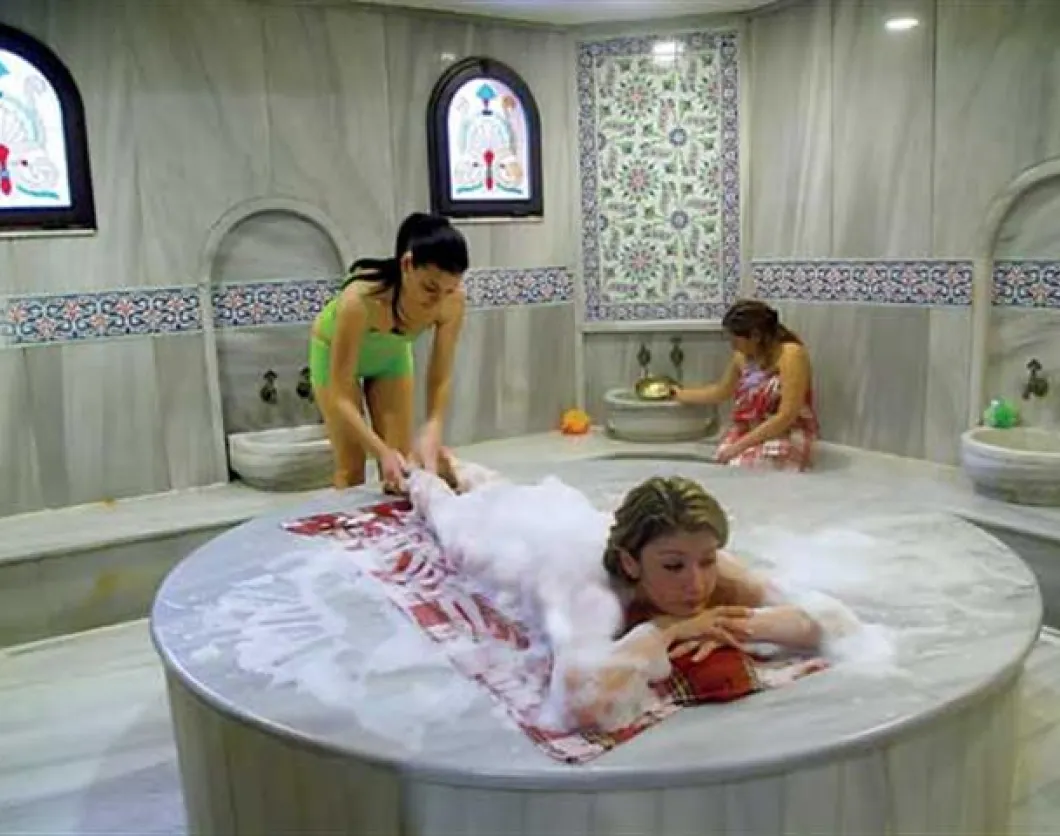For centuries Turkish hammam continues to exist as one of the major components of the Ottoman and Turkish culture with its pestemal, rubber, large and bright dome and unique architectural beauty.
Hammam was built not only as a place for washing oneself. Turkish hammam is also health and entertainment center where people gather and organize social activities.
Hammam is the home of the tradition of physical and spiritual purification. The body and skin are cleaned and purified from toxins, the blood circulation increases, immune system is stimulated so that the physical and mental system are regenerated
Enjoy the Treatment
There are a number of accessories that are specific to the Turkish bath and are still used. Bath gloves that are made of palm root and the Turkish pestemals (bath towels) are the most important ones. Also the pumice stone which is used to rub the feet is always available in the hammam package. Inlaid copper, silver or brass bath bowl is one of the most beautiful examples of handwork.
Hammams in Turkey are open from very early times in the morning until late at nights. The time of stay in the Hammam is not limited. Customers can stay there as long as they want.
After undressing in small cells at the entrance of hammam, people pass to the hot room for taking Turkish bath. The keeper of Turkish hammam asks the customers if they want to have a massage or bath glove. Usually the correct procedure is to have both of them. If massage and bath glove is asked to be provided, after the process of sweating for half an hour, the customer is washed by a masseur or a rubber. Dry pestemals are given to the customers who wish to enjoy sauna after the bath.
Also a spread of a dry pestemal is necessary to lie on the heated marble slab (gobek tashi).
The Turkish Bath temperature varies between 35-45 centigrade degrees according to the season. As for the temperature of sauna, it is between 55-60 centigrade degrees. Firstly rubbers wash their customers and then rub them with the help of a thick bath glove and wash them again.
Lastly, depending on the customer's request, rubber lets the customer to lie on the heated marble slab. Then, begin to massage with his/her skillful hands.
After ending the operations of bathing, rubbing, massage and sauna, the customer passes to the cool room (sogukluk) wrapping himself or herself the a dry pestemal given by the rubber.
There is an attendant waiting to change the pestemals and the towels of the customer. After that the customer goes to the rest room. Here, customers sip delicious drinks that are served to them while resting on the sofa.
What Are the Effects?
Turkish hammam is the home of physical and spiritual purification. There are two types of Turkish baths. These are Turkish baths that are working with artificially heated water and the spas that are working with natural hot water. The healing hot spring water contains sulfur and salt. That's why thermal spas are used in the treatment of rheumatic diseases, skin diseases and nervous breakdown. However, the use of continuous hot water and the ambient temperature of 35-45 centigrade degrees create an environment of high humidity.
This ambience raises the body temperature and activates all the organs. This change is very beneficial to the human body.
Rubbing the body by the bath glove (after staying at the high-humidity environment for a long time), accelerates skin renewal by removing the dead skin cells. This process keeps the skin fresh.
Doctors have been explaining the positive effects of sweating on the human health for centuries. Sweating is as important as breathing for the body. In the historical Turkish bath people sweat approximately 1.5 liters within 15 minutes, which helps the kidneys. Toxins constitute ten percent of sweat. Sweating in the Turkish hammam opens the pores of the skin. Therefore it is frequently used in the treatment of cellulite.
In addition, this method is good for arthritis and many other diseases. It speeds up the heartbeat and blood circulation.
Going to the hammam can be risky for cardiac patients and people with blood pressure problems. These people should consult a doctor before going to the hammam.









